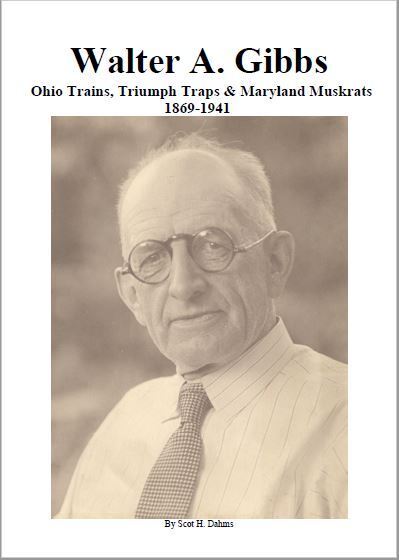-40%
Book-Walter A Gibbs: Ohio Trains, Triumph Traps, Maryland Muskrats 1869-1941
$ 15.83
- Description
- Size Guide
Description
Below is the Foreword from the book and below that are the chapter titles. Book is 300 pages with 190 photographs. Please look for my four other books about Dick Wood, EJ Dailey, Walter Arnold, and the Triumph Trap Company.Walter A. Gibbs was a trapper and trap manufacturer in the early 1900s.
Unlike other trappers of the time, he did not focus on this type of work until after he had retired from a career in electric trains.
Most trappers had to earn their way through the trapping field and earned a meager living while establishing themselves.
Walter already had money and a Harvard education, so he could use his resources to establish himself as a world renown trap manufacturer.
Because of his resources, Walter was able to buy a marsh and test his ideas in trap improvement.
He was able to pay trappers to trap for him and catch enormous amounts of muskrats to test his theories.
Walter was not only instrumental in trap improvement but also in the knowledge of muskrat biology.
His marsh was used as a research location by federal agencies and information used there would impact muskrat management worldwide.
He made in-depth research into muskrat breeding programs and farming.
He also revolutionized the capture of live muskrats for shipping to other areas to restock areas lacking muskrats because of over trapping.
His trap inventions allowed a large number of unharmed muskrats to be shipped worldwide.
Without these traps, this market would have floundered.
Because of his career in electric trains, Walter was very detailed oriented, and sure of himself and his inventions.
He was not afraid to go to court to protect what he considered correct or his patents from infringement.
Walter was part of numerous court cases throughout his life, but most were during his trap manufacturing and muskrat farming days.
Walter was a religious man and stood by his convictions.
He also held others accountable for their actions.
One of his many court cases included a very public accusation of inappropriate behavior by a reverend.
He used local newspapers to make his accusation and the reverend filed a court case against Walter for these accusations.
To tell a complete story of the time and the culture in which Walter lived, I included observations and stories from other persons to show all aspects of the time and place.
The other persons referenced include Edwin LeCompte, E.J. Dailey, Richard K. “Dick” Wood, Vernon Bailey and many others.
I also included information about local impacts Walter had and activities that are inherent to Dorchester County, Maryland.
After his retirement, all of the energy and attention to detail that Walter directed to his career was focused on improvements in trap manufacture and the capture of muskrats.
He developed many unique and important trap improvements.
Many are still used today and were important to the modernization of traps and trapping techniques.
Contents
Foreword…………………………………………………………………...……...4
Chapter 1 - Family...………………………………………………………………5
Chapter 2 – Electric Trains………………………………………………………10
Chapter 3 - The Church Scandal…………………………………………………21
Chapter 4 – Edwin Lee LeCompte ………………………………………………32
Chapter 5 – The Muskrat Industry in Maryland…………………………………36
Chapter 6 – The Fur Ranch………………………………………………………41
Chapter 7 – Patents………………………………………………………………69
Chapter 8 – The Live Market…………………………………………………...133
Chapter 9 – Joseph’s Consolidation………………………………………….…140
Chapter 10 – Dick Wood Pays a Visit………………………………………….149
Chapter 11 – Dorchester County Trappers……………………………………..166
Chapter 12 – Muskrat Farming…………………………………………………172
Chapter 13 – Local Competition………………………………………………..175
Chapter 14 – The Three Jaw Trap…………………………………………........198
Chapter 15 – Harmon Thompson…………………………………………….....217
Chapter 16 – Montgomery Ward……………………………………………….222
Chapter 17 – Piper……………………………………………………………...231
Chapter 18 – Practical Muskrat Raising…………………………………..........233
Chapter 19 – Using Gibbs Traps………………………………………………..236
Chapter 20 – Pennsylvania Beaver……………………………………………..241
Chapter 21 – E.J. Dailey and the American Trappers Association……………..246
Chapter 22 – The United States Muskrat Experimental Station………………..253
Chapter 23 – Blackwater Migratory Bird Refuge………………………………265
Chapter 24 – The Triumph and Animal Trap Companies……………………...269
Chapter 25 – The North Carolina Marsh……………………………………….277
Chapter 26 – Muskrat Ranching………………………………………………..280
Chapter 27 – The National Outdoor Show of Dorchester County……………...287
Chapter 28 – The Brilliant, Litigious Engineer………………………………...292
References in Chronological Order…………………………………………….294









